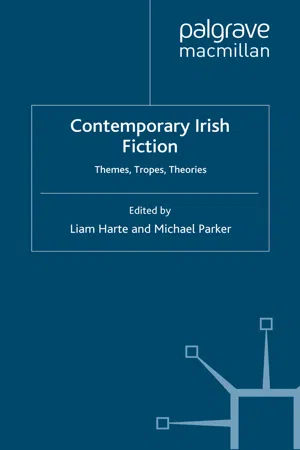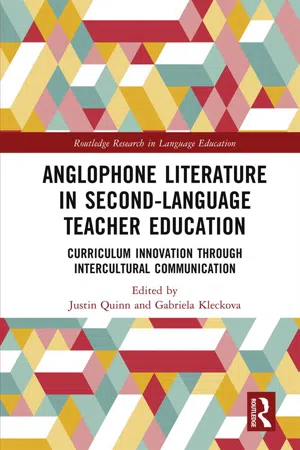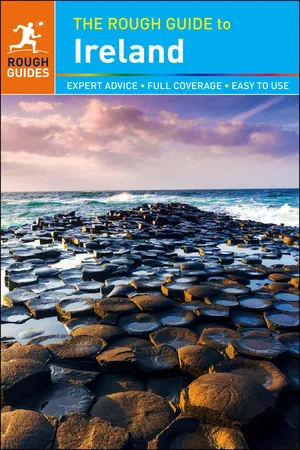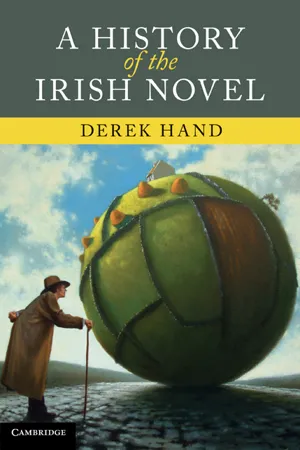Literature
Northern Irish Literature
Northern Irish literature refers to the body of literary works produced in Northern Ireland, often reflecting the region's complex history, politics, and cultural identity. It encompasses a wide range of genres, including poetry, fiction, and drama, and has been shaped by the unique social and political landscape of the region. Themes such as conflict, identity, and reconciliation are often prominent in Northern Irish literature.
Written by Perlego with AI-assistance
Related key terms
1 of 5
5 Key excerpts on "Northern Irish Literature"
- eBook - PDF
Contemporary Irish Fiction
Themes, Tropes, Theories
- L. Harte, M. Parker, L. Harte, M. Parker(Authors)
- 2000(Publication Date)
- Palgrave Macmillan(Publisher)
14 In a culture where Otherness continues to function as a haunting presence within definitions of identity, often inducing uncertainty and a profound sense of threat, much contemporary writing both replicates this tense introspectiveness and exhibits a strong desire to reach 4 Contemporary Irish Fiction beyond this state. Indeed, Glenn Patterson has characterized the Northern Irish novelist as typically Janus-faced, finding a certain free- dom in a duality of imaginative vision: As writers we are often pulled in seemingly contrary directions, looking inwards and appealing outwards. In reality, though, there need be no contradiction, for […] in trying to understand one place very well it might just be possible to understand many other places at least in part. 15 So while the perception of the North as a static, anomalous ‘tightly enclosed province bounded by outworn loyalties and obscure alle- giances’ 16 still prevails in some quarters, the determination and energy of many artists to imagine it otherwise acts as a compelling counter- point. Moreover, any informed discussion of contemporary Northern Irish fiction must increasingly take account of the impact of external as well as internal literary, cultural and political forces. One has only to consider the influence of Graham Greene on the late Brian Moore, for example, or that of Flannery O’Connor on Bernard Mac Laverty, or of Salman Rushdie on Patterson, to appreciate the diverse formal, stylistic and ideological influences which have shaped recent fiction from the North of Ireland. If, as one critic suggests, ‘[r]eligious affiliation, cultural identity, repressive ideology, taut family relationships and sexual restraint’ 17 were the chief elements of the thematic paradigm of Northern fiction up to 1969, since then, writers, like many others in the divided society which they aspire to represent, have come under consistent pressure to politicize their material. - eBook - ePub
Anglophone Literature in Second-Language Teacher Education
Curriculum Innovation through Intercultural Communication
- Justin Quinn, Gabriela Kleckova, Justin Quinn, Gabriela Kleckova(Authors)
- 2021(Publication Date)
- Routledge(Publisher)
7 Literature, political conflict, and intercultural understanding Teaching the Northern Irish Troubles Charles I. ArmstrongIntroduction
One of the key roles for literature in a modern conflict is as a conscience and witness to atrocity. With such a role comes a perspective that is not simply aligned with any particular identity, institution, or authority. Although occasionally reduced to being a monument to national, cultural essences, literature is fundamentally a form of communication that crosses and challenges borders. As such, it is a source of intercultural understanding and transaction, which potentially can make sense of—and perhaps also contribute to resolving—political conflicts between different communities and cultures. This chapter will use the Northern Irish Troubles as a test case, to explore how these issues may be confronted in the classroom. It will make use of my own experience instructing future English teachers at a Norwegian university.Intercultural shadows
Typically, such instruction has used literature to educate future Norwegian teachers about British language and culture. As Karen Risager points out, however, the traditional national paradigm is vulnerable to both objections and alternatives:Language teaching can deal with many kinds of identities, including national and ethnic ones, but it has to understand them as processes that take place between particular players under particular historical and geographical circumstances in multicultural communities that form and develop across existing national boundaries. Modern language studies therefore have to break with the traditional national paradigm and start to define a transnational paradigm that places language teaching in a transnational and global context.1The shift addressed here by Risager concerns not only the content of language studies but also the daily lives and broader horizons of the students who undertake them. She heralds “a greater focus on the individual students,” evident in “an interest in the development of their consciousness and personality in connection with work on the foreign cultures seen in relation to their own cultural background.” This relation leads to different results: a comparative relationship between cultures, self-reflection on the student’s own position, and an ethical dimension evident in what she calls “the understanding of ‘the other.’” These relations underpin, in Risager’s account, concepts such as intercultural competence and the intercultural speaker, the latter denoting “a person who is able to mediate between various languages and various cultural contexts.”2 - eBook - PDF
- (Author)
- 0(Publication Date)
- Rough Guides(Publisher)
However, these themes were already apparent in the work of the major writers from Northern Ireland in the early and mid-twentieth century: John Hewitt and Louis MacNeice . In the work of MacNeice, who is often associated with the British poetry movement of the 1930s that included Cecil Day Lewis, Stephen Spender and W. H. Auden, one finds an ambiguous relationship with the country of his birth, though his focus on the west of Ireland in particular, in poems such as Galway and Western Landscape , anticipates the concern with this part of the island in the work of the next generation of Protestant poets, Michael Longley and Derek Mahon. Meanwhile Hewitt promoted his belief in cultural regionalism, in writing from and for the community in the North from which he emerged: 613 LITERATURE CONTEXTS I write for my own kind I do not pitch my voice that every phrase be heard by those that have no choice: their quality of mind must be withdrawn and still, as moth that answers moth across a roaring hill. Irish-language literature in the twentieth century The Revival was important for the emergence of prose writers in Irish in the twentieth century, most notably Galway-born Pádraic Ó Conaire , the author of over four hundred short stories, several plays, numerous essays and the ground-breaking novel Deoraíocht (Exile; 1910), still one of the most remarkable Irish works of fiction and regarded as the first modern novel in the Irish language. Set in London at the beginning of the twentieth century, the narrative concerns an Irish emigrant, who after losing an arm and a leg and being seriously disfigured in an accident shortly after arriving from Galway, ends up working in a travelling circus as a sideshow freak. Autobiography emerged as an important form in Irish-language literature in the early twentieth century. - eBook - PDF
- Derek Hand(Author)
- 2011(Publication Date)
- Cambridge University Press(Publisher)
That many of these writers (such as Joyce and Edgeworth) produced works that seem to test, stretch and break the boundaries of what a novel is thought to be – in fact, might be thought as not being novels at all – means the impression still lingers that the novel is singularly unsuited to the task of rendering the Irish world and Irish experience. Within this context, this history of the Irish novel is a history of the struggle towards articulation, of making the novel form express Irish stories and Irish concerns. It is also a history of developing Irish identities, of misrepresentations and the effort by writers to offer something genuinely authentic and complicatedly real. The novel – its sheer size – allows for the bringing together of difference in terms of native and visitor, Gaelic and Anglo-Irish, Catholic and Protestant, aristocrat and peasant. Thus the pages of the Irish novel are where issues concerning identity are played out repeat- edly. Ireland’s colonial relationship to Britain is obviously figured in this confrontation between differing identities and differing loyalties. It will be possible, in addition, to reflect on Irish culture’s developing relationship not only to Britain but also to Europe, America and the wider world in the contemporary moment of globalisation. A history of the Irish novel is a history of power and authority, a history of questions concerning colonial and native narratives, and of questions surrounding who speaks and writes and who is spoken and written about. A gradual movement from exclusively Anglo-Irish authors up to the nineteenth century, to the emergence of Irish authors in the nineteenth and twentieth centuries registers that shift in power and its consequences for a culture imagining and reimagining itself. The novel in the nineteenth century, for instance, becomes a medium through which the nascent middle-class Catholic population can aspire to power and Introduction: A history of the Irish novel, 1665–2010 5 - eBook - PDF
Voices from the Margins
Gender and the Everyday in Women's Pre- and Post- Agreement Troubles Short Fiction
- Mercedes del Campo, Eamon Maher(Authors)
- 2021(Publication Date)
- Peter Lang Group(Publisher)
36 Nonetheless, these women writers have significantly contributed to the literature of the Northern Irish conflict, ‘setting a new standard of sensibility’ 37 and offering ‘more reflective, less thriller-based treatments of the Troubles con- text’. 38 A look at female authors’ literary production in Northern Ireland more generally – not just with the conflict as a major theme – also reveals that they have been very prolific writers. Many of the writers mentioned in this book have written about non-conflict-related themes and so have also many other women such as Caroline Blackwood, Cathy Kelly, Sharon Owens, Anne Dunlop, Mary A. Larkin, Sheila Llewelyn, Bernie McGill, Anne-Marie Neary, Jan Carson, Evelyn Conlon and Lucy Caldwell in fic- tion; Janet Shepperson, Joan Newman, Ann Zell, Ruth Carr (Hooley), Colette Bryce, Deirdre Catmill, Grainne Tobin and Miriam Gamble in poetry; and Nicola McCartney, Brenda Winter, Christina Poland, Jo Egan, Maria Connolly, Abbie Spallen and Stacey Gregg in drama. The negative responses of literary criticism to Northern Irish women writers’ preferred stylistic and thematic choices could explain why they have not received the same critical attention as Northern Irish male writers. Although female authors have also made use of non-realist forms, realism 36 Bill Rolston. ‘Literature of the Troubles: Novels’. CAIN Web Service: Conflict and Politics in Northern Ireland; and Patrick Magee. Gangsters or Guerrillas? Representations of Irish Republicans in ‘Troubles Fiction’. Belfast: Beyond the Pale, 2001. 37 Magee. Gangsters or Guerrillas? 114. 38 Magee. Gangsters or Guerrillas? 8. ‘Almost beneath notice’ 31 has been at the core of most of their writing. 39 Responses to their continued use of realism, especially in Northern Ireland, have not always been positive, an inconsistent critical evaluation considering that the canonized fiction of Roddy Doyle, John McGahern, Brian Moore or Bernard MacLaverty is ‘rooted in realism’.
Index pages curate the most relevant extracts from our library of academic textbooks. They’ve been created using an in-house natural language model (NLM), each adding context and meaning to key research topics.




